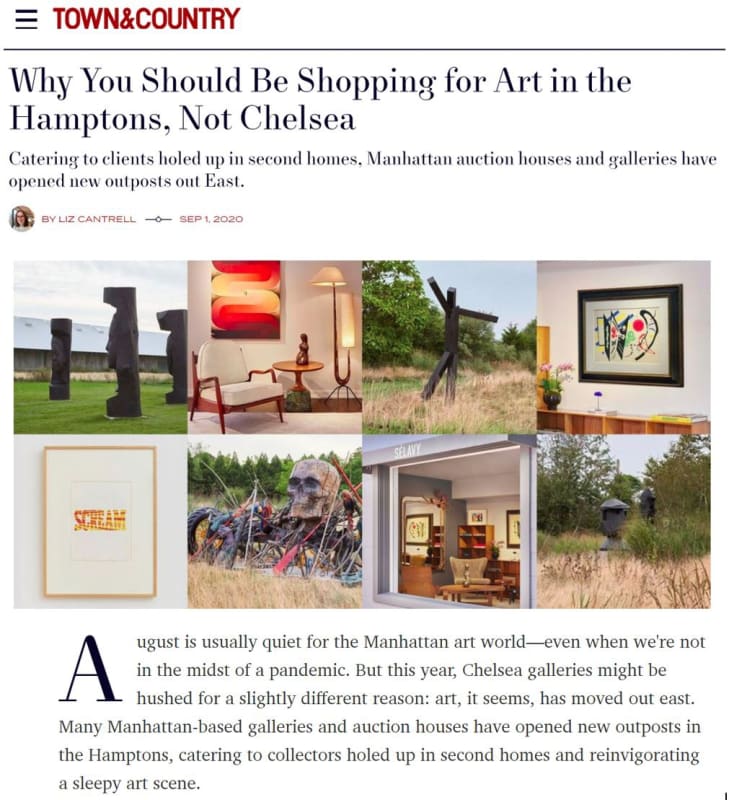August is usually quiet for the Manhattan art world—even when we're not in the midst of a pandemic. But this year, Chelsea galleries might be hushed for a slightly different reason: art, it seems, has moved out east. Many Manhattan-based galleries and auction houses have opened new outposts in the Hamptons, catering to collectors holed up in second homes and reinvigorating a sleepy art scene.
Auction house Phillips opened a Southampton location in early August and did so with a bang—displaying a huge Basquiat in the window that will be sold in November. Sotheby's set up shop in East Hampton, with works by Richard Serra and David Hockney. Hauser & Wirth also debuted a two-story, 5,000 square foot gallery space in Southampton. All are available for private appointment—and are here to stay. Additionally, Pace Gallery opened an East Hampton outpost, showcasing drawings from the Donald B. Marron Collection, including works by Brice Marden and Ed Ruscha.
Another exciting addition is Sélavy in Southampton, a shoppable salon by Emannuel and Christina Di Donna, of Madison Avenue stalwart Di Donna Galleries. The couple noticed that friends and clients who moved to their second homes during the pandemic were looking to improve their living spaces, and to do so quickly.
"People are looking to update or elevate their homes here with with art, and they want to buy something and take it home with them that day," Christina Di Donna tells T&C. "Whether it's pair of chairs or a new painting, they want it now and they want to live with it."
For several years, the Di Donnas had been thinking about creating a sort of salon that, while still showcasing the Surrealist style for which they are known, was more approachable than a staid, white-wall gallery setting. When the pandemic hit, they signed a three-year lease on a Southampton space with a large front window. Passerby looking through the window encounter an upscale, inviting home scene.
"We put a QR code on the door, so you could scan on your phone and get all of the details, the prices, the provenance of all the works inside," Di Donna explains, noting that the gallery also takes private appointments. "It's like a living room, so we have a chaise lounge, a pair of chairs around the coffee table, bookshelves, and then paintings, objects and sculptures are scattered throughout just as they would be in your home. It's a bit more playful and it's a bit more approachable. The shows we do in the gallery in the city are very historical and academic, whereas here we have the freedom to do more decorative, livable installations."
According to one young collector, philanthropist Larry Milstein, these recent openings "feel less like a museum experience and more of a retail offering, where the process of buying or experiencing art doesn’t need to be so detached from normal routine. It feels like a great deal of noise has been removed."
Further afield in Montauk is the new South Etna Montauk, a joint venture by husband-and-wife gallerists Amalia Dayan, who co-runs Luxembourg & Dayan, and Adam Lindemann, who operates Venus Over Manhattan. The gallery's first exhibition, “Painting is Painting’s Favorite Food: Art History as Muse,” features more than 20 works by the likes of Derrick Adams, John Currin, and Lynette Yiadom-Boakye.
Of course, existing galleries out east are also beefing up their offerings— and sometimes changing how exhibitions are structured. The Parrish Museum in Water Mill has opened Field of Dreams, an inaugural sculpture exhibition created to extend the galleries outdoors, allowing for a socially-distant viewing experience. There are works by 10 artists, including Theaster Gates, Jim Dine, Joel Perlman, and Roy Lichtenstein, in a variety of genres, spread throughout the museum's 14-acre grounds.
And, although Southampton Art Center is showcasing works in a more traditional gallery setting, its new 2020 Vision exhibition is a direct response to the uncertainty, loss, pain, anxiety, and violence of this year. The center invited artists and writers, including Adam Pendleton and Clifford Owens, to create new works about what they had experienced this year—from the ongoing pandemic to the widespread protests and calls for racial justice following the police killings of Breonna Taylor, George Floyd, Ahmaud Arbery, and others. It will be on view through December 27, open to the public without appointment, but with social distancing measures and face mask mandates in place.
